|
Participant Perspective - July
24, 2001
 Interview
with Jeff Engebretson Interview
with Jeff Engebretson
Ecological Microbiologist - Western Washington Univ.
Jeff
G: What project are you working on at Axial Volcano?
Jeff
E: I'm working with bacterial traps, which are 3 little PVC pipes
filled with glass wool with nytex screens on either side to keep out larger
organisms that eat bacteria. The idea is to place the bacterial traps
on top of a hydrothermal vent for short term (1-2 week) and long term
(1-2 year) studies. We'll come back and collect the samples and freeze
them on the ship. Once we get to land we start the process of extracting
DNA. We acquire the DNA signature through a method called TRFLP (Terminal
Restriction Fragmental-length Polymorphism). It's relatively new - so
good, clean methods haven't been developed yet. That's what I'm working
on. The method doesn't allow us to identify specific bacteria but definitely
distinguishes between one bacterial community and the next. It also allows
us to compare the similarities of the communities. It's a good first-approximation
method to try and figure out which communities are related at different
vent sites. We don't even know how many types of hydrothermal vent ecosystems
there are. This project has helped push that question a little further
and developed some of the answers.
Jeff
G: What do you think of being at sea for extended periods of time.
Jeff
E: It's interesting. Before I come out I have mixed feelings about
it. It's really great to be out here with scientists from multiple disciplines.
I learn a lot about the geology, chemistry and the macrobiology. In terms
of the living conditions it's like a sensory depravation tank. After about
a week out here all my dreams are about the ship. This continues for the
first week I get back to shore because all my short-term memory is of
ship-associated events. It's nice to be out of the academic atmosphere
at school, where there's always pressure to get things done. Out here
there's definitely some slower moments where you can relax with a colleague
and have discussions for as long as you want. When you're on land you're
possibly seeing over a hundred people per day. The environments are open
spaces. Out here, the commute is two floors up to "home" and
to work in the lab you walk back down those same two flights of stairs.
Being outside here is nice for the sunlight, fresh air and ocean view,
but it's pretty nondescript. You're senses are deprived.
Jeff
G: How did you become interested in environmental microbiology?
Jeff
E: The vents are places where there's new exciting things to learn.
Our knowledge here is limited, when compared to a lot of other types of
ecosystems. What really got me into environmental microbiology is the
idea of life on other planets. In my lifetime I'd like to see feasible
cruises to places like Mars or Europa. We're possibly in the beginning
stages of developing methods to sample on places like Europa. We'd have
to drill under two kilometers of ice, travel down to the seafloor to collect
samples, analyze them and send the information back to Earth. Developing
methods here that transfer to interplanetary exploration is a really exciting
field to me. This type of exploration addresses some big picture questions:
What life is, how fragile or tough it is. If we want to explore other
planets there are so many environments on Earth that we could practice
in.
|

